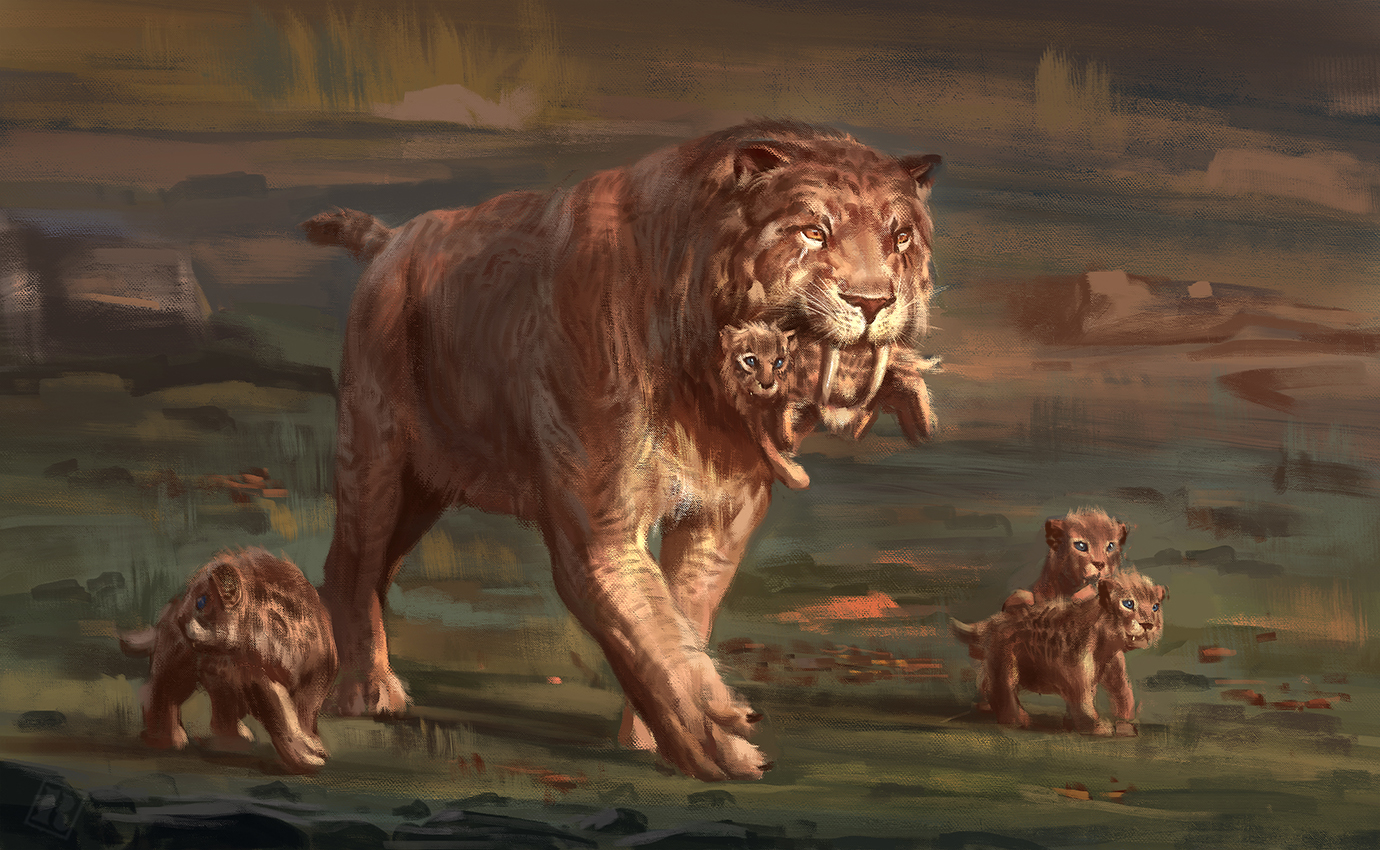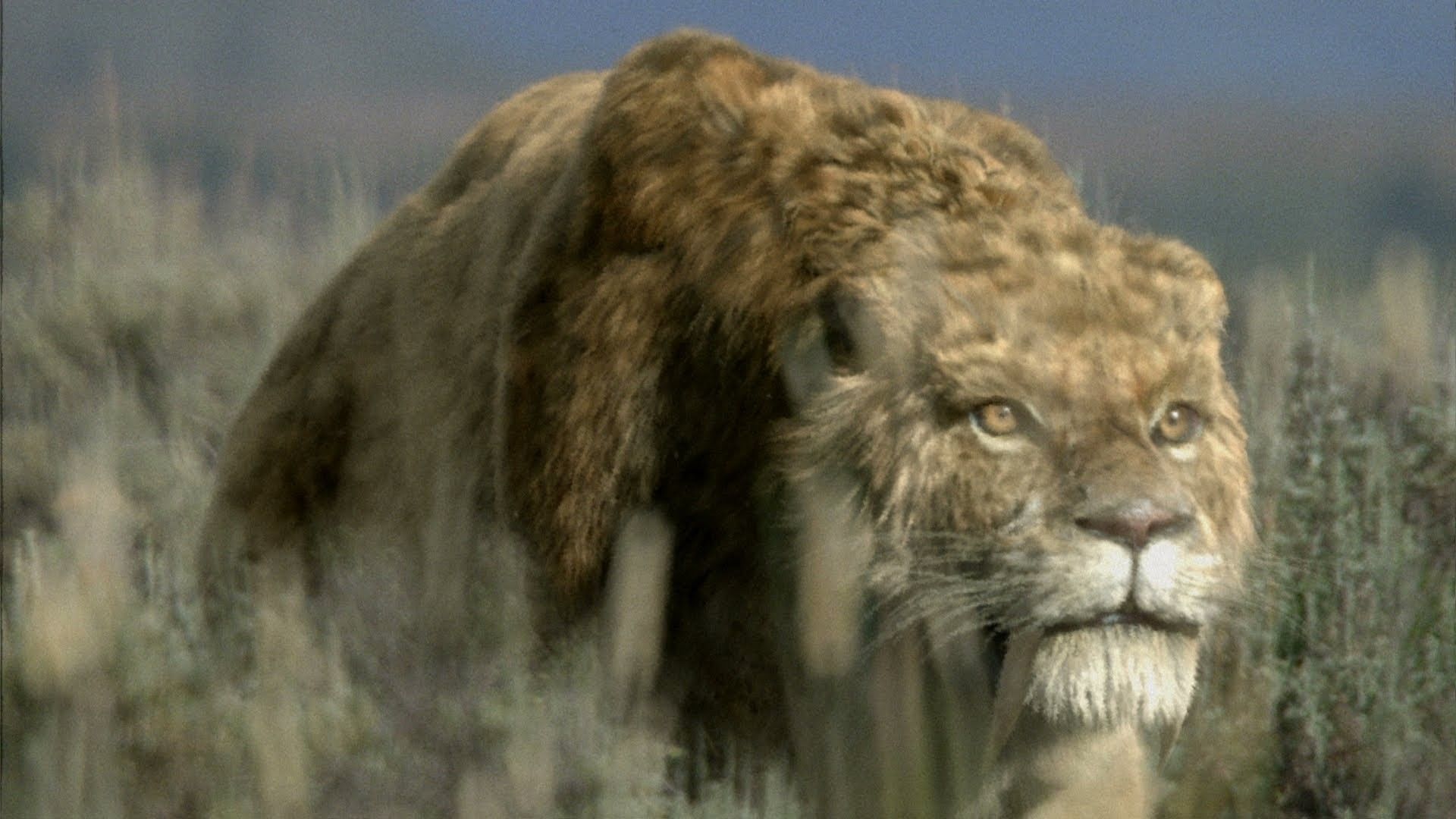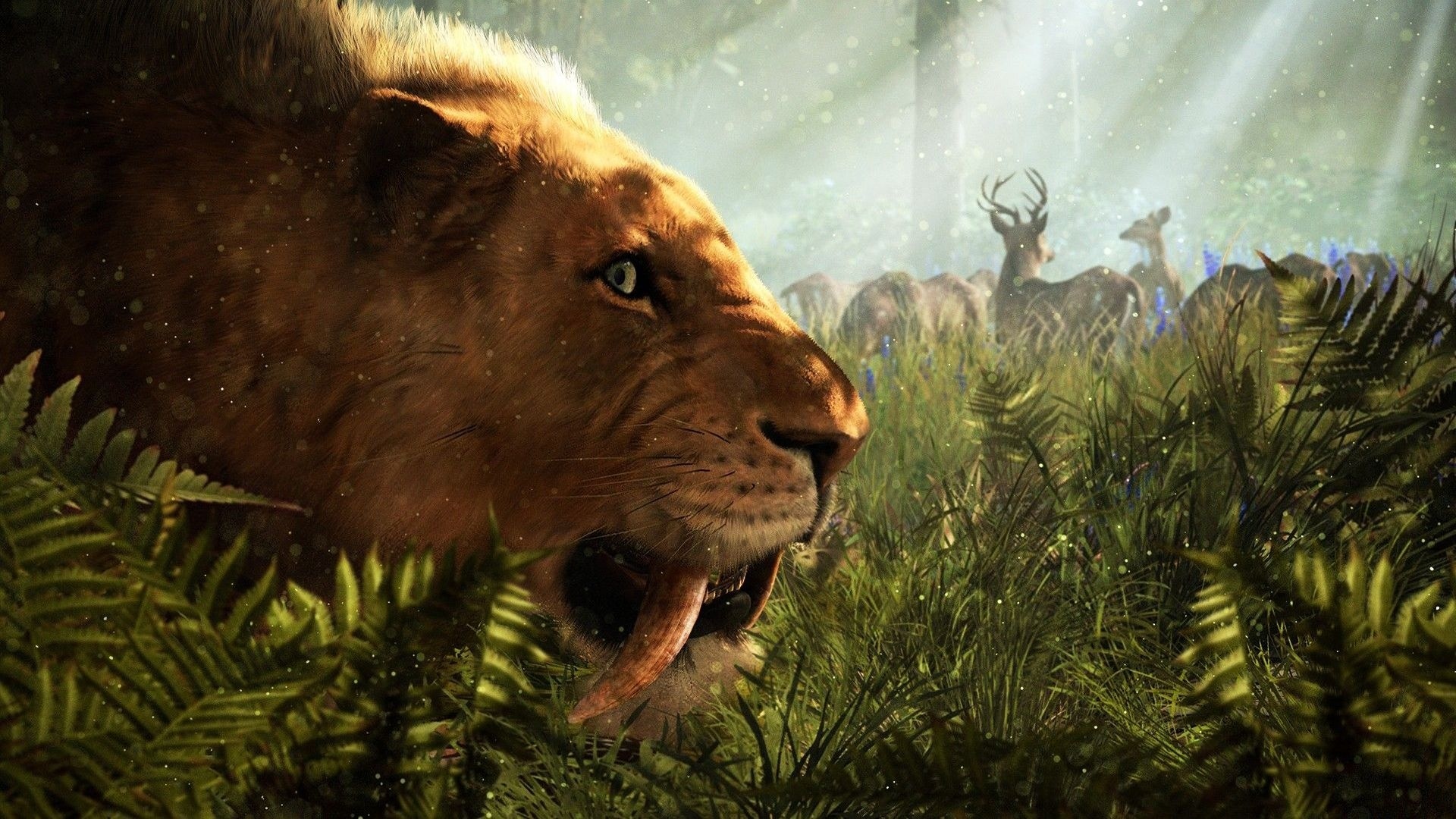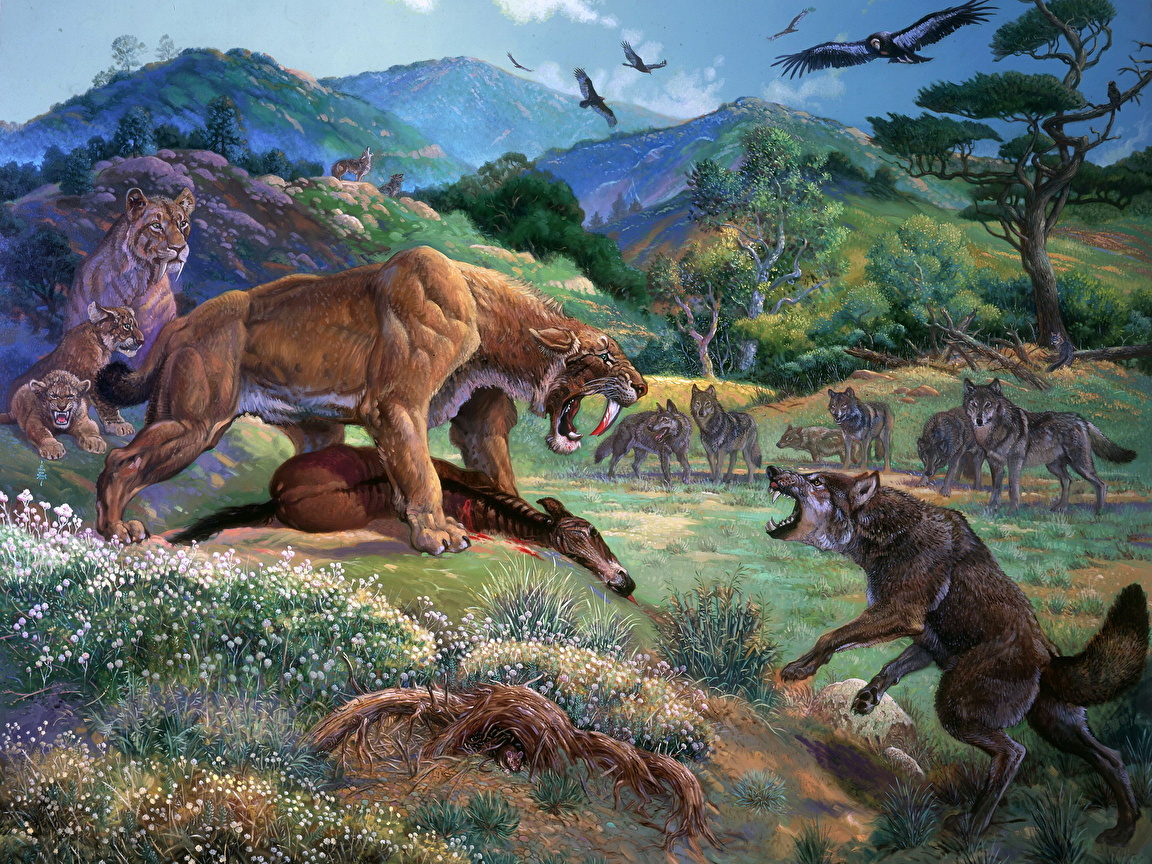In fact, there is no evidence that the saber-toothed tiger was striped, like its modern namesake. With the present panthera tigris, the prehistoric predator had a common ancestor, was successful in hunting and strong, but, like many species of mammals, died out at the beginning of the Holocene.
Material Content:
What is the name of the saber-toothed tiger
Predatory monsters with saber-shaped fangs (Machairodontinae) belong to the extinct subfamily of feline mammals. According to the theory of evolution, the progenitor of the glorious family felidae lived about 20 million years ago. Then, representatives with conical and saber-shaped fangs separated from one branch. Among the saber-toothed, two genera stood out - smilodon and homotherium.
The ancestors of smilodons were called meganthereons. They had long fangs flattened from the sides without notches and powerful legs like lions. Predators inhabited everywhere except the Australian continent and Antarctic ice. The last descendants of meganterions lived in the American territories at the end of the Pleistocene.
The homoteries who lived to see the Holocene were distinguished by their skeleton structure, appearance, and habits from Smilodon. The Mahairodes, who died out about 2 million years ago, are considered to be his ancestors. The name of the genus Machairodus comes from the likeness of the teeth of animals to the bent swords of the mahairam.
In ancient times, there were other prehistoric monsters with front fangs that resembled saber-toothed tigers:
- creodonts;
- tilakosmily;
- nimravids;
- barburofelides.
The descendants of these animals have not survived in the modern fauna.The jaws of the creodonts resembled crocodiles, they could snack on the victim, but they were rather weak, the brain volume was smaller than that of real cats. Tilacosmils were marsupials, and nimravids and barburofelids only resembled cat-like animals.
Description of the prehistoric predator
Giant cats smilodony and homotherium differed not so elegant proportions as modern representatives of the cat family. They were characterized by large size, powerful musculoskeletal system and huge front fangs - the deadly weapon of ruthless predators.
No one knows what the saber-toothed tiger looked like, what the color of the extinct predator actually was. Scientists believe that spots or stripes stood out against a plain yellowish-brown background for better camouflage, but it is impossible to establish the truth from ancient remains.
Dimensions and Weight
In some individuals of the Smilodon populator, the weight reached 400 kg, as in the giant hybrid of a lion and a tiger - a ligra. More common was a medium-sized predator, Smilodon fatalis.
Description smilodona fatalis:
- weight from 160 to 280 kg;
- body length of about 2 meters excluding a 30-centimeter tail;
- growth at the withers - up to 120 cm.
Homotheria (Homotherium) were more modest in size and weight. They were like modern lions: height at the withers was 110 cm, body weight did not exceed 200 kg. These predators were different from other large cats, and the structure resembled a cross between modern hyenas and bears.
Structure
The body of smilodons varied from modern tigers and lions to stocky. They were much more powerful and coarser folded, with a relatively low growth at the withers, they had a lot of weight. A distinctive attribute, which, according to scientists, helped to kill game - huge fangs. They resembled curved sabers, and reached a length of 28 cm along with the root. To use such a weapon, the predator had to open its mouth at 120 °, which is not available to the modern cat.
The fangs of the homotherias were shorter, but wider than the smilodon and with special curts that helped break the game. Predators had an elongated skull with a special crest, to which chewing muscles were attached. The lower jaw had outgrowths protecting the upper fangs. The forelimbs looked longer than the hind limbs, and the pelvic region resembled a bear, so the animals could not jump as beautifully as other feline ones. The nose of animals had an interesting structure - thanks to the large nasal passages of a square shape, the brain quickly cooled, receiving the necessary amount of oxygen.
The habitat of extinct animals
Saber-toothed cats were found on all continents except Antarctica and Australia. In Europe, they inhabited the territory of the North Sea, which used to be land. Predators entered the lands of North America along the Bering Isthmus, which existed in ancient times on the site of the Strait of the same name.
Homoterias occupied the same territory as smilodons in the south of the range, and in the northern part they did not have competitors. Animals lived in open forests, prairies, forests and pampas of North and South America, in the jungle and savannah of Africa, as well as in the vastness of Eurasia.
In Africa, competition with other large representatives of the feline family was the most intense, and homotheria left the mainland about 500 thousand years ago. In Eurasia, they lived until the late Pleistocene, having disappeared from their usual habitats about 30 thousand years ago. Most of the remains of predatory monsters were found in America, where they became extinct about 10 thousand years ago.
Nutrition and lifestyle
There is no reliable information about how prehistoric saber-toothed predators lived. Scientists only make assumptions about their taste preferences, social habits, and behavior patterns.
There is a hypothesis that extinct animal smilodons lived in packs, headed by 1 or 2 male leaders. The remaining members of the flock were females and young. Mostly females hunted, not particularly different in size and body shape from males.They were more nimble and quick, providing killed animals with growing individuals and the elderly. The "elderly" animals, having lost their fangs and the ability to hunt independently, ate common prey with other members of the pack.
Long and sharp fangs with serrations on the inside, resembling sabers, served animals in order to cut through the victims' throats. They pressed the caught game to the ground with powerful front paws, and dealt a mortal blow with fangs. If the victim was large, smilodons hunted as a group, trying to inflict fatal wounds during a general attack.
Homoterias occupied another ecological niche. Their prey consisted of trunk mammals and slow big game. They lived and hunted alone. Perhaps the female herself raised the cubs, and until they grow up, she shared with them her hunting grounds and killed animals. Homoterias could not run fast, but were hardy and able to go long distances in search of food. The victim was attacked from an ambush by jumping from the bottom branch of a tree.
Cause of extinction
The cause of the extinction of saber-toothed tigers is not known to scientists. Only nature itself could remove these powerful predators from the face of the Earth, who did not have competitors and natural enemies. When the last smilodons disappeared, people still lived in caves. Hunting with spears and stone axes could not lead to the destruction of a population of large animals.
Interestingly, according to Plato’s narratives, around the 10th millennium BC, the mythical Atlantis was flooded. Then, when not only smilodons became extinct, but also other large mammals. Scientists attribute the catastrophe to the fall of a large meteorite and global climate change.
Some paleontologists express a version about the insufficient genetic diversity of saber-toothed tigers, which led to the degeneration of the population.
Interesting facts about saber-toothed cats
A large number of remains of saber-toothed predators were found in California. From the tar pits located on the La Brea ranch, paleontologists extracted the remains of animals that existed on Earth during the late Pleistocene. You can see the collection of ancient fauna in the Museum of Los Angeles.
In South America, before its reunion with North, dwelled tilakosmil - a marsupial saber-toothed tiger. He looked like representatives of the cat family only outwardly, but belonged to a completely different squad. His giant front fangs grew all his life, and his teeth reached the frontal bone. In the lower jaw there were special “sheaths” that protected large front teeth with a closed mouth. After South and North America united by a land area, tilakosmil died out, unable to withstand the competition of predators coming from the north.
In the near future, scientists plan to clone saber-toothed tigers using genetic material from prehistoric predators found in permafrost. The best egg donor and “surrogate mother” will be an African lioness.




















